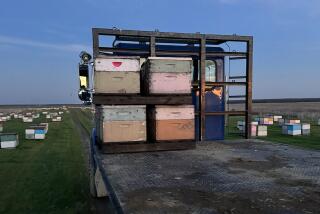Social imbalances speed honeybee colony collapse
Environmental stressors that push honeybees to begin foraging earlier in life can cause a domino effect on hives, accelerating their sudden collapse, a new study suggests.
The study, published online Monday in the journal Proceedings of the National Academy of Sciences, showed that too many young bees leaving the hive can cause a tipping point in the tightly regulated social dynamics of a hive, leading to colony collapse within weeks.
That insight into the decade-old disorder came from researchers who use the bees to study neuroscience.
Molecular biologist Clint Perry of Queen Mary University, London, had been collaborating with neurobiologist Andrew Barron of Macquarie University, in Sydney, Australia, on studies that examine how bees make decisions and communicate in ways that contribute to a social “superorganism.”
But they grew increasingly troubled by news that bee colonies were collapsing, jeopardizing crops that depend on them for pollination.
“You can’t not have an emotional reaction to the organism you study and love,” said Barron. “I think every bee researcher in the world has a responsibility to respond to the colony collapse situation, no matter what we call ourselves.”
The pair already were gluing miniature radio frequency identification tags on hundreds of bees, and realized that this tracking, which is similar to systems used to prevent retail theft, could be used to investigate bees under stress.
Studies have linked the stress of Varroa destuctor mites, the gut parasite Nosema, and certain pesticides and agricultural chemicals to so-called precocious foraging - bees leaving the hive much earlier.
“There was a suggestion that there was some type of difference between precocious foragers and normal aged foragers,” said Perry.
So the researchers set up experimental hives that would in effect force bees to begin foraging earlier. They filled them only with day-old bees and collected information on their movements in and out of the hive. They also tracked bees in a normal hive, where social roles are regulated by pheromones, keeping age demographics in balance.
Without any social inhibitions, bees from the stressed hives began going on exploratory flights before they reached 14 days of age, and they spent less time outside, completed fewer flights and were less likely to survive their first foray, the data showed.
Plugging age-influenced factors into computer models of hive dynamics gave them scenarios in which precocious foraging might push the hive toward a “tipping point,” beyond which it could not recover.
Colonies regularly buffer against unexpected high loss of foragers by sending bees out earlier in their life cycle, but they rapidly return to stability. But if mortality roughly doubled, the model showed, the colony would be locked in a negative feedback loop of more young bees foraging at younger ages, leading to less stored food and fewer brood -- baby bees.
“Since the younger bees are not as good at it, they are going to die sooner, and they’re going to not be bringing back as much food, thereby causing more younger bees to go out, and more younger bees to not do as well, and that will cause continuous feedback that will destroy the colony in a short time,” said Perry.
“What you see is what people report in a colony collapse situation,” said Barron. “The colony looks like it’s doing OK. It looks like it’s doing what normal colonies do – it’s got high feed, it’s got foragers, it’s got brood, but you come back about two weeks later and you’ve got an empty box.”
California beekeeper Randy Oliver, who was not involved in the study, said the model fits the evidence he has documented.
“What we observe in the field is the sign of a poor bee-to-brood ratio, an indicator that adult bees are dying more rapidly than the colony can replace them,” Oliver said. “Sudden collapse may soon follow.”
University of Maryland entomologist Dennis vanEngelsdorp cautioned that the modeled scenarios will have to be field tested.
“It would be great to see similar work when colonies with normal age distributions are manipulated by removing one age cohort and then seeing how the model holds up,” he said.
The authors are continuing their radio-tagging experiments and hope to come up with ways to diagnose a colony at risk of collapse. Current methods that look at the amount of brood and honey don’t catch the phenomenon in time, said Barron.
“There’s not going to be a single solution to colony collapse, because there’s not a single cause,” Barron added. “The priority is finding ways that we can identify colonies at risk of failure as early as possible so you can intervene and do whatever you need to do to support them and to help them heal themselves.”
Get a buzz out of science? Follow me on Twitter: LATsciguy







